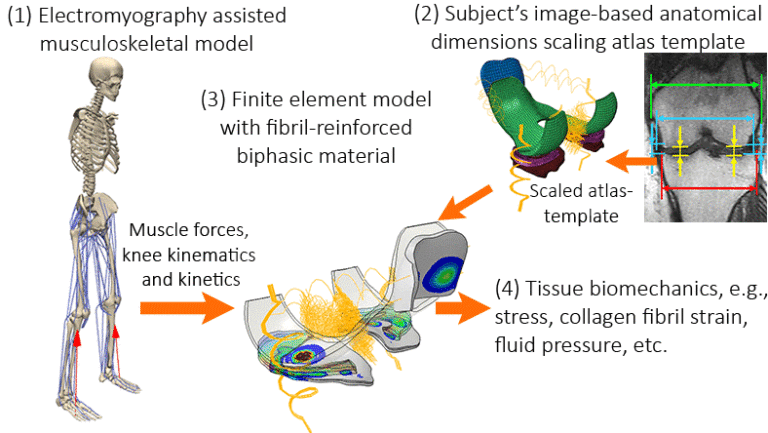Knee osteoarthritis (KOA), ranked among the leading causes of disability across the globe, reduces the quality of life by causing chronic pain, inflammation, and joint stiffness. Excessive tissue mechanics (e.g., stress and strain) have been shown to deteriorate cartilages and develop KOA due to, e.g., collagen network damage, cell death, and loss of proteoglycans. In this study, we introduced and evaluated a rapid musculoskeletal (MS) finite element (FE) modeling pipeline to estimate person- and task-specific cartilage mechanics governing tissue degradation responses.
We estimated knee mechanics in 15 KOA individuals performing six different daily activities consisting of walking, chair sit-to-stand, chair stand-to-sit, picking up an object from the ground, stair ascent, and stair descent. As muscle recruitment strategy may be affected by KOA, we also investigated whether assisting the MS analysis with the subject’s muscle activation patterns (i.e., electromyography data) affects the results compared to conventional static-optimization MS analysis.
Our results showed significantly lower discrepancies between the experiments and estimated muscle activations and joint contact forces using the EMG-assisted workflow compared to the static-optimization method. Within the lateral tibial cartilage, the maximum of tissue mechanical responses was highest in stand-to-sit, sit-to-stand, and pick-up and was lowest during walking. Within the medial tibial cartilage, the maximum of the tissue mechanical responses was not substantially different between the activities.
To conclude, our results emphasized the importance of assisting the MS-FE analysis with subjects’ muscle activation patterns, especially when simulating different physical activities of KOA individuals. This was the first study to establish a neuromusculoskeletal finite element modeling pipeline with a focus on its feasibility for a rapid clinical assessment tool. Our future studies will investigate the potential of the developed workflow for assisting clinicians with personalized prevention or treatment-planning of KOA.

